Page 17 of 64
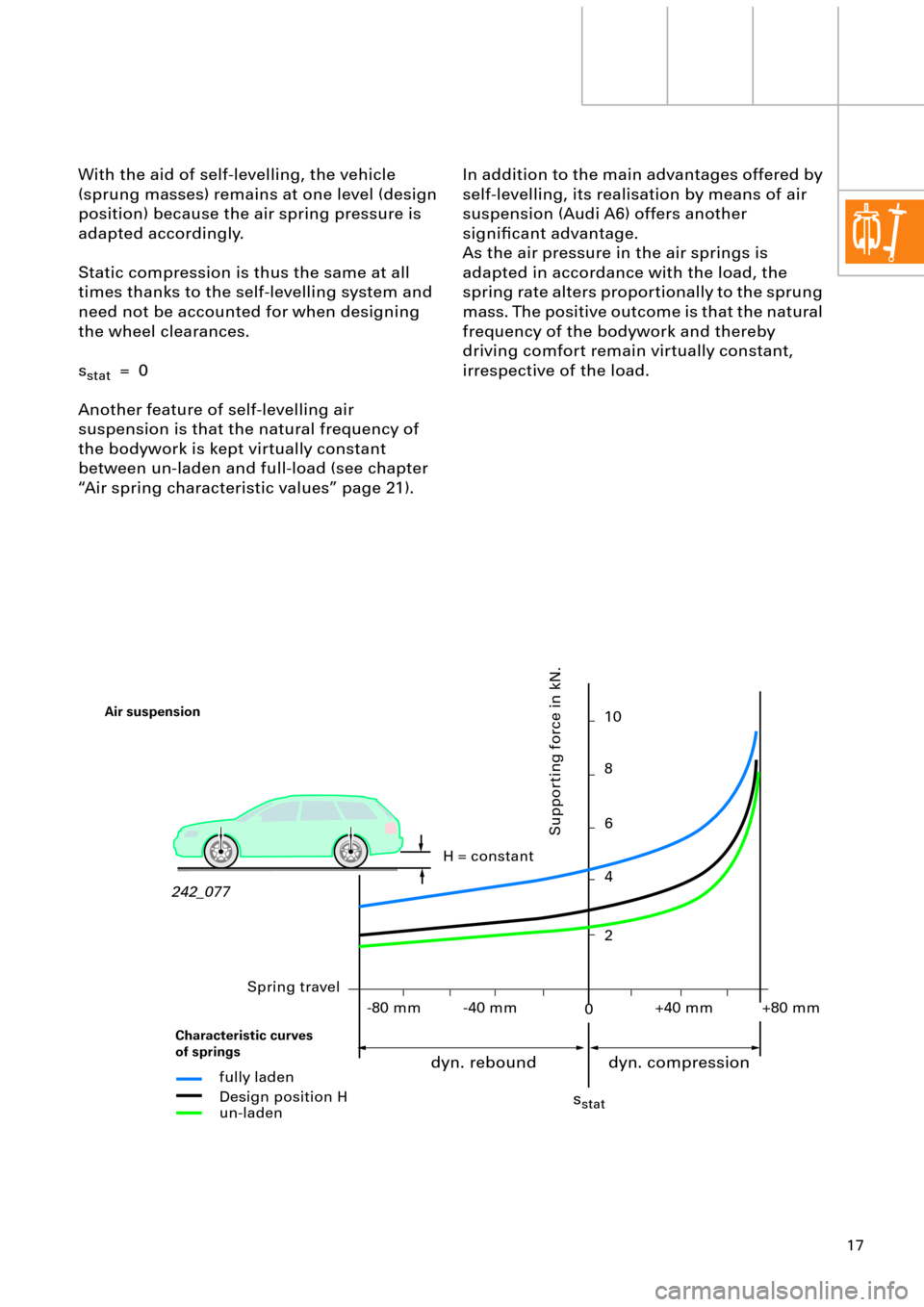
17
In addition to the main advantages offered by
self-levelling, its realisation by means of air
suspension (Audi A6) offers another
signiÞcant advantage.
As the air pressure in the air springs is
adapted in accordance with the load, the
spring rate alters proportionally to the sprung
mass. The positive outcome is that the natural
frequency of the bodywork and thereby
driving comfort remain virtually constant,
irrespective of the load. With the aid of self-levelling, the vehicle
(sprung masses) remains at one level (design
position) because the air spring pressure is
adapted accordingly.
Static compression is thus the same at all
times thanks to the self-levelling system and
need not be accounted for when designing
the wheel clearances.
s
stat = 0
Another feature of self-levelling air
suspension is that the natural frequency of
the bodywork is kept virtually constant
between un-laden and full-load (see chapter
ÒAir spring characteristic valuesÓ page 21).
242_077H = constant
fully laden
Design position H
un-laden
sstat
0
Supporting force in kN.
10
8
6
+80 mm+40 mm-40 mm -80 mm4
2
Air suspension
dyn. rebound dyn. compression
Spring travel
Characteristic curves
of springs
Page 18 of 64
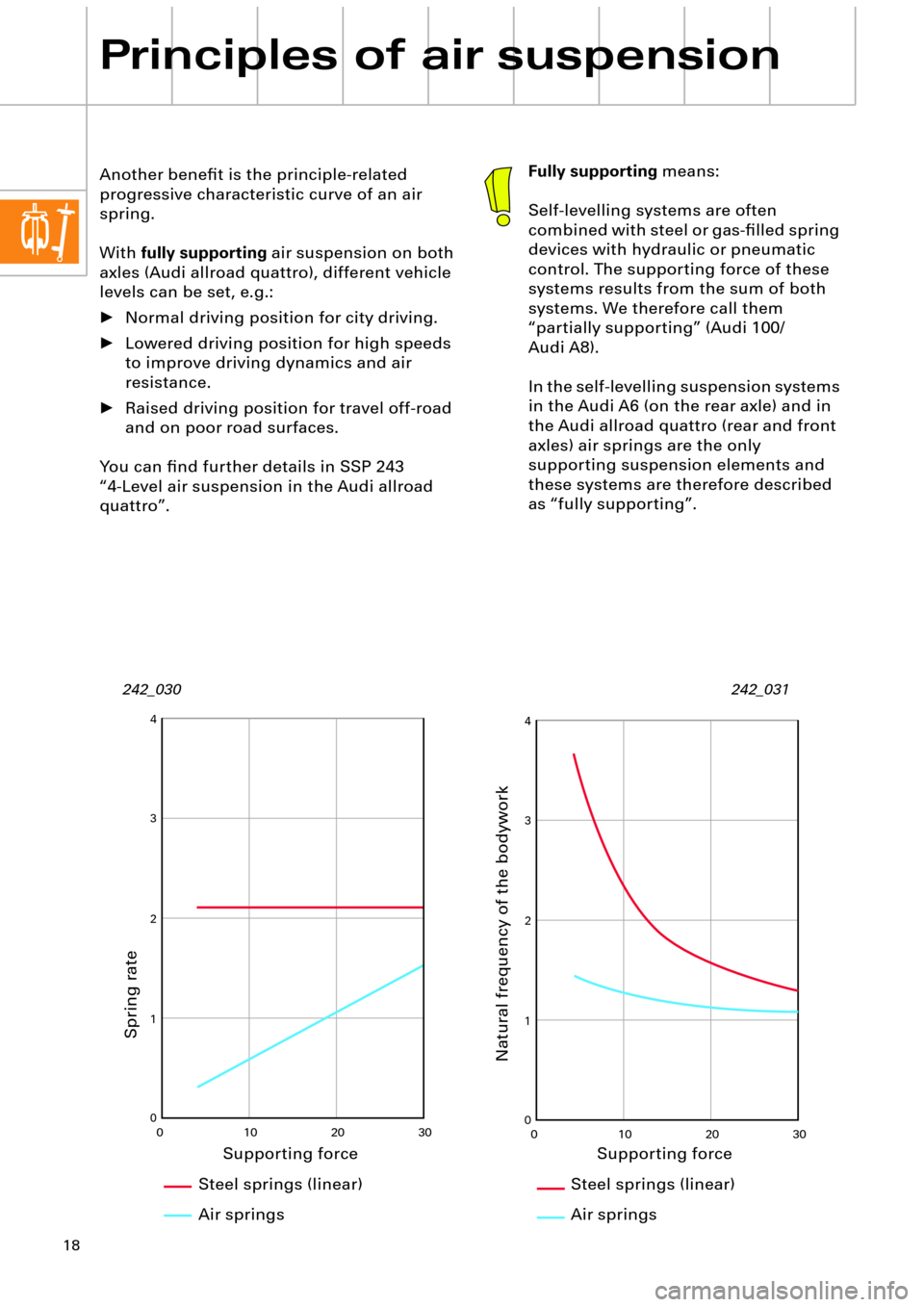
18
Principles of air suspension
Another beneÞt is the principle-related
progressive characteristic curve of an air
spring.
With fully supporting air suspension on both
axles (Audi allroad quattro), different vehicle
levels can be set, e.g.:
¥ Normal driving position for city driving.
¥ Lowered driving position for high speeds
to improve driving dynamics and air
resistance.
¥ Raised driving position for travel off-road
and on poor road surfaces.
You can Þnd further details in SSP 243
Ò4-Level air suspension in the Audi allroad
quattroÓ.Fully supporting means:
Self-levelling systems are often
combined with steel or gas-Þlled spring
devices with hydraulic or pneumatic
control. The supporting force of these
systems results from the sum of both
systems. We therefore call them
Òpartially supportingÓ (Audi 100/
Audi A8).
In the self-levelling suspension systems
in the Audi A6 (on the rear axle) and in
the Audi allroad quattro (rear and front
axles) air springs are the only
supporting suspension elements and
these systems are therefore described
as Òfully supportingÓ.
0 1 2
3 40 102030
242_030
Spring rate
0 1 2
3 40 102030
Natural frequency of the bodywork
Supporting force
242_031
Supporting force
Steel springs (linear)
Air springsSteel springs (linear)
Air springs
Page 19 of 64
19
Design of the air springs:
In passenger vehicles, air springs with
U-bellows are used as suspension elements.
These allow greater spring travel in restricted
spaces.
The air springs consist of:
¥ Upper housing closure
¥ U-bellows
¥ Piston (lower housing closure)
¥ Retaining rings
The construction of the U-bellows can be
seen in Þg. 242_032.
242_032
The outer and inner surfaces are made of an
elastomer material. The material is resistant
to all weather inßuences and is largely oil-
resistant. The inner surface Þnish is designed
to be particularly air-tight.
The stability supports absorb the forces
produced by the internal pressure in the air
springs.
Upper housing closure
Retaining ring
Internal surface coating
Woven insert 1
Woven insert 2
External surface coating
Piston
Coaxial arrangement of the air springs
Page 20 of 64
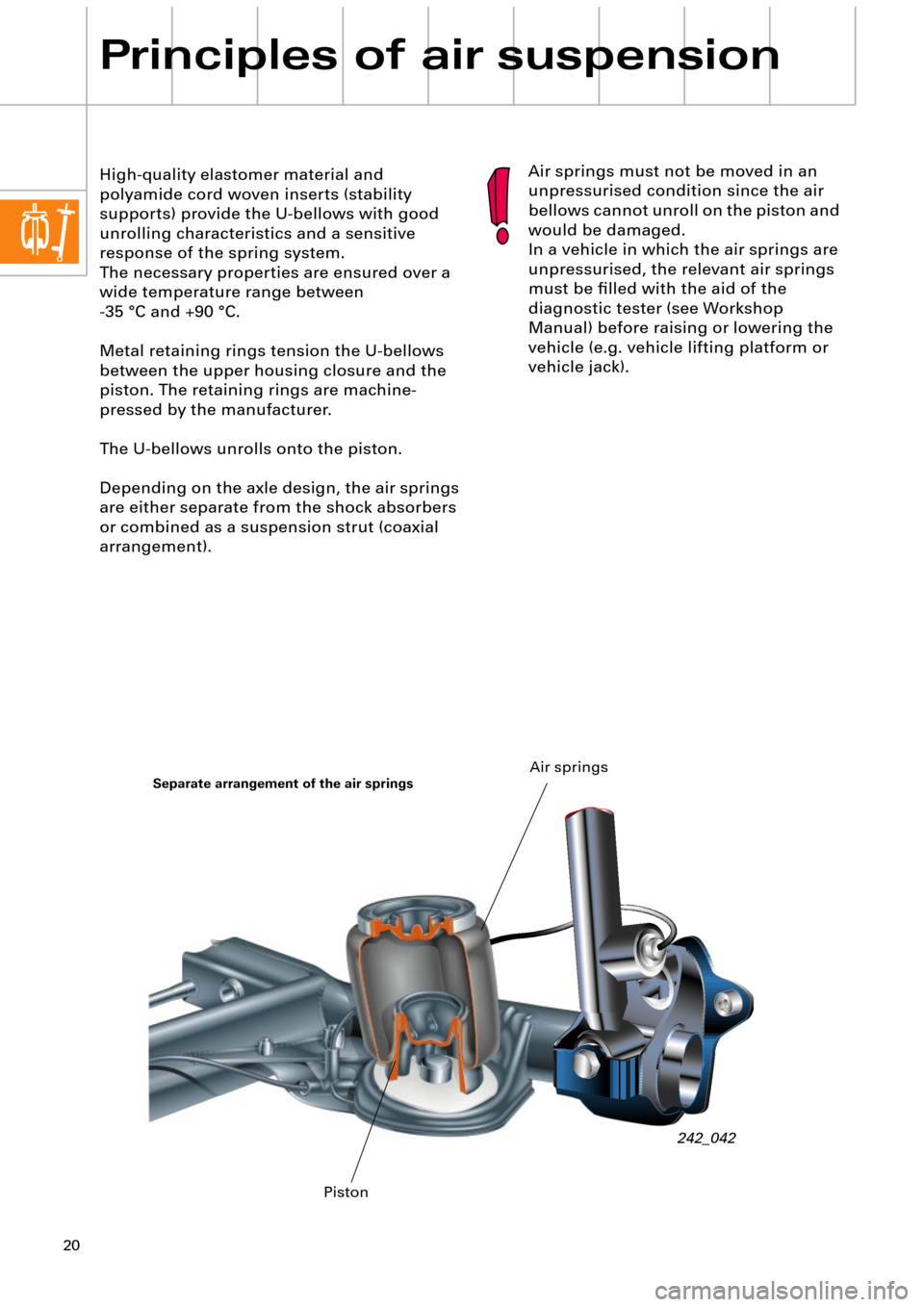
20
Principles of air suspension
High-quality elastomer material and
polyamide cord woven inserts (stability
supports) provide the U-bellows with good
unrolling characteristics and a sensitive
response of the spring system.
The necessary properties are ensured over a
wide temperature range between
-35 ¡C and +90 ¡C.
Metal retaining rings tension the U-bellows
between the upper housing closure and the
piston. The retaining rings are machine-
pressed by the manufacturer.
The U-bellows unrolls onto the piston.
Depending on the axle design, the air springs
are either separate from the shock absorbers
or combined as a suspension strut (coaxial
arrangement).Air springs must not be moved in an
unpressurised condition since the air
bellows cannot unroll on the piston and
would be damaged.
In a vehicle in which the air springs are
unpressurised, the relevant air springs
must be Þlled with the aid of the
diagnostic tester (see Workshop
Manual) before raising or lowering the
vehicle (e.g. vehicle lifting platform or
vehicle jack).
242_042
Separate arrangement of the air springs
PistonAir springs
Page 21 of 64
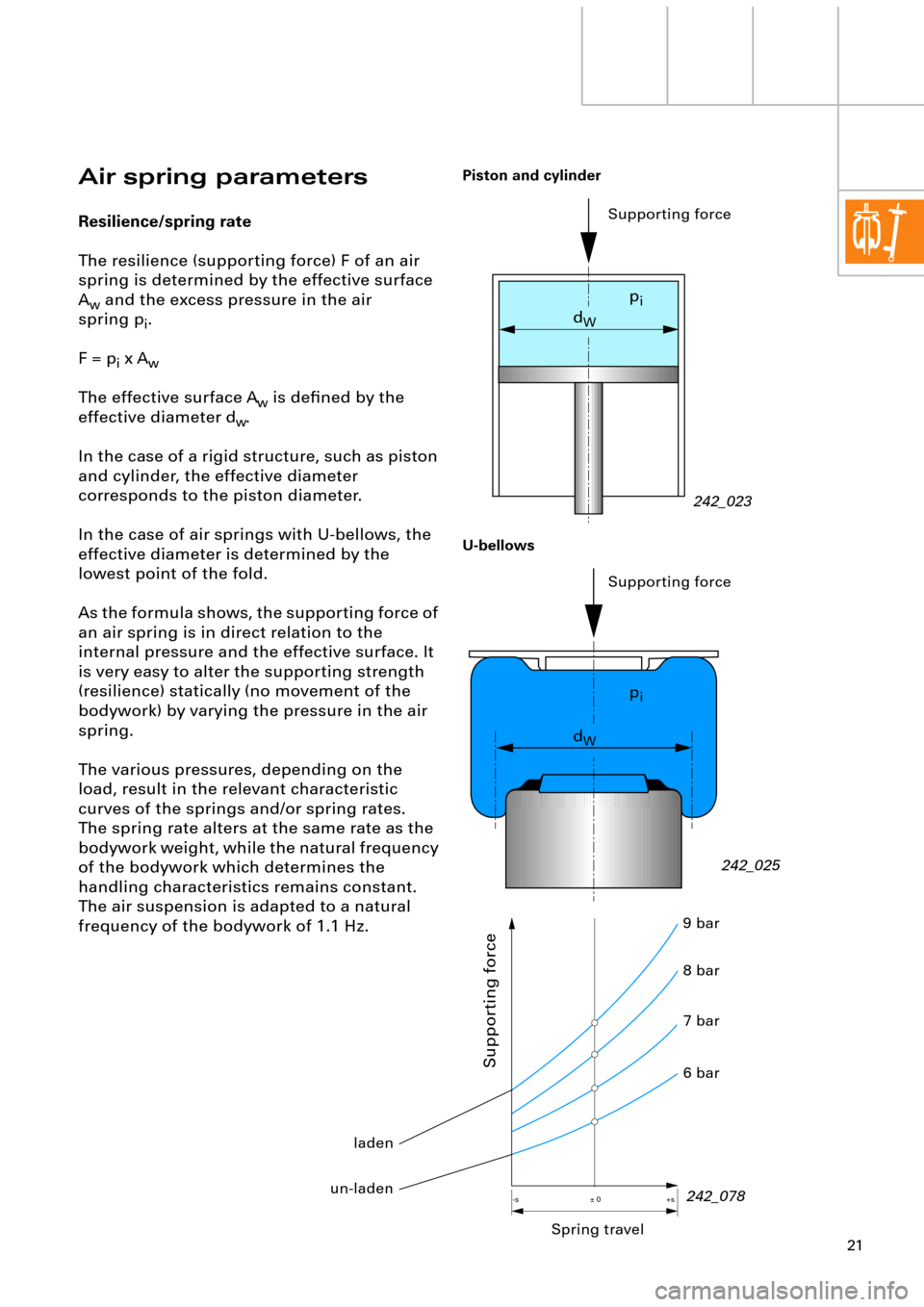
21
-s +s± 0
Air spring parameters
Resilience/spring rate
The resilience (supporting force) F of an air
spring is determined by the effective surface
A
w and the excess pressure in the air
spring p
i.
F = p
i x Aw
The effective surface Aw is deÞned by the
effective diameter d
w.
In the case of a rigid structure, such as piston
and cylinder, the effective diameter
corresponds to the piston diameter.
In the case of air springs with U-bellows, the
effective diameter is determined by the
lowest point of the fold.
As the formula shows, the supporting force of
an air spring is in direct relation to the
internal pressure and the effective surface. It
is very easy to alter the supporting strength
(resilience) statically (no movement of the
bodywork) by varying the pressure in the air
spring.
The various pressures, depending on the
load, result in the relevant characteristic
curves of the springs and/or spring rates.
The spring rate alters at the same rate as the
bodywork weight, while the natural frequency
of the bodywork which determines the
handling characteristics remains constant.
The air suspension is adapted to a natural
frequency of the bodywork of 1.1 Hz.
242_023
242_025 Supporting force
dW
Supporting force
dW
Piston and cylinder
U-bellows
Spring travel
Supporting force
242_078 6 bar 7 bar 8 bar 9 bar
pi
pi
laden
un-laden
Page 22 of 64
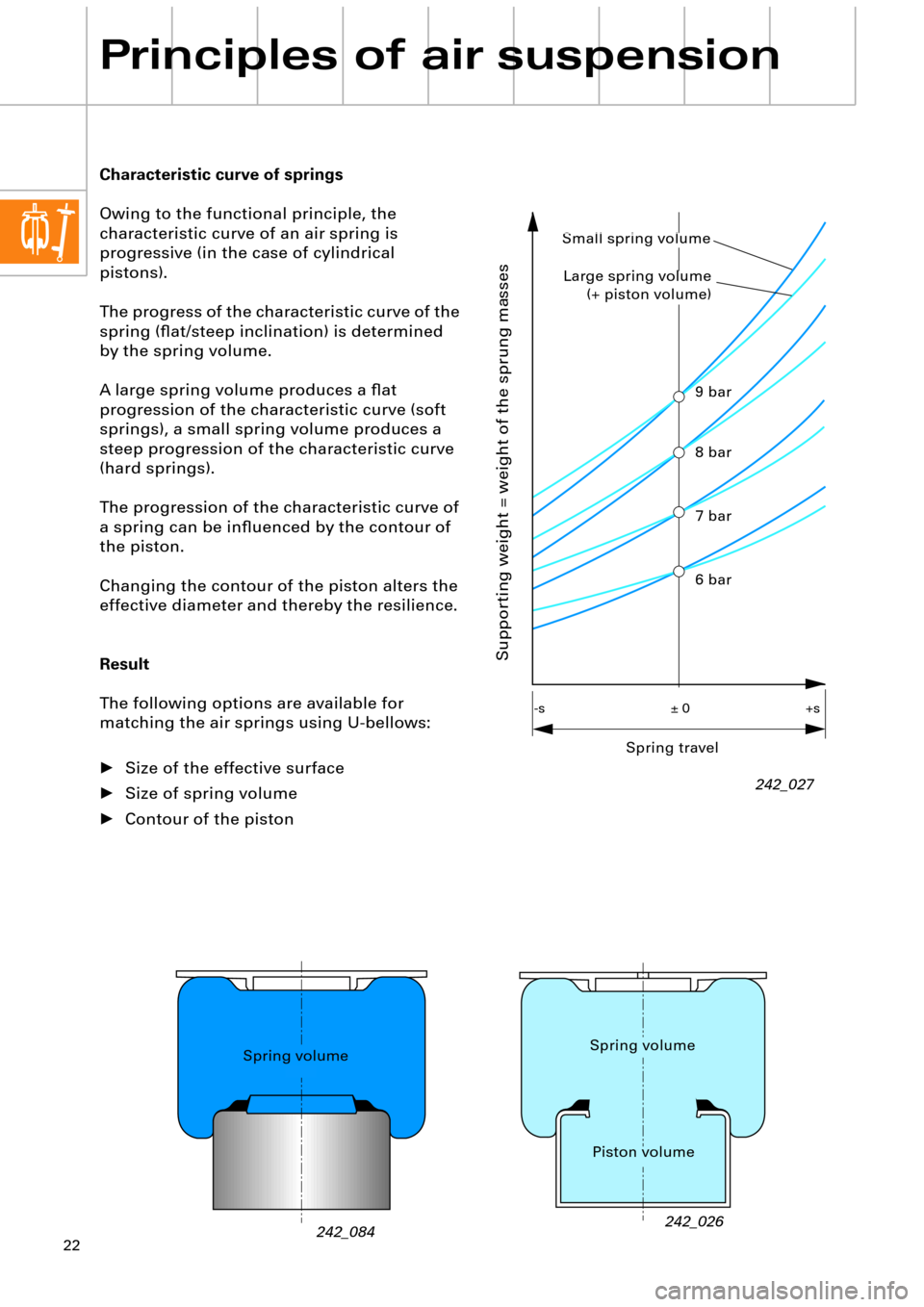
22
-s+s 0
Characteristic curve of springs
Owing to the functional principle, the
characteristic curve of an air spring is
progressive (in the case of cylindrical
pistons).
The progress of the characteristic curve of the
spring (ßat/steep inclination) is determined
by the spring volume.
A large spring volume produces a ßat
progression of the characteristic curve (soft
springs), a small spring volume produces a
steep progression of the characteristic curve
(hard springs).
The progression of the characteristic curve of
a spring can be inßuenced by the contour of
the piston.
Changing the contour of the piston alters the
effective diameter and thereby the resilience.
Result
The following options are available for
matching the air springs using U-bellows:
¥ Size of the effective surface
¥ Size of spring volume
¥ Contour of the piston
Principles of air suspension
242_026242_027
Spring volume
Piston volume
Small spring volume
Large spring volume
(+ piston volume)
Spring travel
Supporting weight = weight of the sprung masses
6 bar 7 bar
8 bar 9 bar
242_084 Spring volume
Page 23 of 64
23
Example of the contour of a piston
(suspension strut in the Audi allroad quattro)
Vibration dampers are available in different
designs but their basic function and purpose
are the same.
Hydraulic/mechanical damping has found
widespread application in modern vehicle
design. The telescopic shock absorber is now
particularly favoured due to its small
dimensions, minimum friction, precise
damping and simple design.
Vibration damping
Without vibration damping, the vibration of
the masses during driving operation would
be increased to such an extent by repeated
road irregularities, that bodywork vibration
would build up increasingly and the wheels
would lose contact with the road surface.
The purpose of the vibration damping system
is to eliminate vibrations (energy) as quickly
as possible via the suspension.
For this purpose, hydraulic vibration dampers
(shock absorbers) are located parallel to the
springs.
242_079
U-bellows
Piston
Compressed
Page 24 of 64
24
Principles of air suspension
As previously mentioned, vibration damping
has a fundamental effect on driving safety
and comfort.
However, the requirements of driving safety
(driving dynamics) and driving comfort are
conßicting.
Within certain limits, the following applies in
principle:
¥ A higher rate of damping improves driving
dynamics and reduces driving comfort.
¥ A lower rate of damping lessens driving
dynamics and improves driving comfort.The term Òshock absorbersÓ is
misleading as it does not precisely
describe the function.
For this reason we shall use the term
Òvibration damperÓ instead.
242_022 Damped vibration
Un-damped vibrationUneven groundDirection of
travel Sprung mass
Unsprung mass